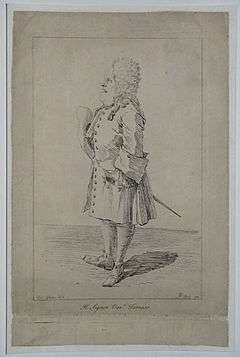Sir Thomas Dereham, 4th Baronet
| Sir Thomas Dereham, 4th Baronet | |
|---|---|
 Medal of Thomas Dereham aged 36 by Massimiliano Soldani Benzi[1] | |
| Born |
1678 West Dereham Abbey, Norfolk, England |
| Died |
16 January 1738 (aged 59) Rome, Italy |
| Nationality | English |
| Known for | Informal Jacobite ambassador to Rome |
Sir Thomas Dereham, 4th Baronet (or Derham) (ca. 1678-1739) was an English baronet who spent most of his life in Italy, where he acted as an informal representative for the Old Pretender, known as James III to his supporters.
Birth and education
Sir Thomas Dereham was born in West Dereham Abbey, Norfolk.[2] He was the grandchild of Sir Thomas Dereham, 1st Baronet, who was made a baronet by Charles II of England on 8 June 1661. His father was Thomas's second son, Sir Richard Dereham, and his mother was Frances Villiers.[3] Dereham was an Anglo-Catholic.[4] He was given into the care of his cousin, also called Thomas Dereham, envoy to the court of Tuscany. He later inherited the property of his cousin.[2] He was educated in Florence at the court of Cosimo III de' Medici, Grand Duke of Tuscany.[3]
Career
Jacobite representative

Dereham moved to Rome where he acted on behalf of the Old Pretender, James Francis Edward Stuart, known as James III to his supporters, in dealings with Pope Clement XII and the local English community who supported the Stuart cause.[4] For many years Dereham was a close friend of Clement XII and his nephew, Cardinal Andrea Corsini. In March 1733 Baron Philipp von Stosch, a resident of Rome who was paid to report on events to the English government, wrote that, "Sir Thomas Dereham is playing the part of the Pope's favorite, and is extremely influential with Cardinal Corsini."[5] Stosch said he acted as a Minister and considered that he was "protector of the British nation."[6]
Scientific interests
Dereham became a Fellow of the Royal Society in 1720.[7] He sent regular reports on Italian science from Italy to the Royal Society. In 1722 he entered into a correspondence with James Jurin, secretary of the Royal Society, and with Sir Isaac Newton, President of the Society, in which he offered to act as an intermediary in "opening a Philosophical Communication between two nations, among both which have been, & are so many generous spirits, as you say, united in the same noble design, for the common benefit, & information of mankind." He reported on the development of the Academy of the Institute of Sciences and the Arts of Bologna, recently founded by Luigi Ferdinando Marsigli, and of the society being developed in Milan, promoted by Celia Grillo Borromeo. Dereham undertook a translation into Italian of the Philosophical Transactions of the Royal Society, whose first volume appeared in 1729.[4]
Dereham assisted when a decision was made in 1739 to place orders with the London-based instrument maker Jonathan Sisson for a 3 feet (0.91 m) telescope, a 3 feet (0.91 m) mural quadrant and a 2 feet (0.61 m) portable quadrant for the Bologna Institute of Science.[8]
Death
Dereham did not marry. He died in Rome on 16 January 1739 aged sixty-five. He left an endowment to be administered by the "de Propaganda Fide" college in Rome to support to English students as Roman Catholic missionaries in Rome.[2] His funerary monument is in the Venerabile Collegio Inglese (Venerable English College) in Rome.[9]
References
Citations
- 1 2 British Museum. Dept. of Prints and Drawings 1877, p. 402.
- 1 2 3 Hawkins, Franks & Grueber 1885, p. 447.
- 1 2 Burke & Burke 1838, p. 159.
- 1 2 3 Findlen 2009.
- ↑ Corp 2011, p. 218.
- ↑ Corp 2011, p. 243.
- ↑ "Library archive". Royal Society. Retrieved 2013-02-27.
- ↑ McConnell 2007, p. 78.
- ↑ McFerran 2008.
Sources
- British Museum. Dept. of Prints and Drawings (1877). Catalogue of prints and drawings in the British museum. Division 1. Political and personal satires. Printed by order of the Trustees. Retrieved 2013-01-20.
- Burke, John; Burke, John Bernard (1838). A genealogical and heraldic history of the extinct and dormant baronetcies of England, by J. and J.B. Burke. Scott, Webster, and Geary. Retrieved 2013-01-19.
- Corp, Edward (2011-08-18). The Stuarts in Italy, 1719-1766: A Royal Court in Permanent Exile. Cambridge University Press. ISBN 978-0-521-51327-2. Retrieved 2013-01-20.
- Findlen, Paula (1 May 2009). "Founding a Scientific Academy: Gender, Patronage and Knowledge in Early Eighteenth-Century Milan". Republics of Letters: A Journal for the Study of Knowledge, Politics, and the Arts 1 (1). Retrieved 2013-01-19.
- Hawkins, Edward; Franks, Sir Augustus Wollaston; Grueber, Herbert Appold (1885). Medallic illustrations of the history of Great Britain and Ireland to the death of George II. Printed by order of the Trustees of the British Museum. Retrieved 2013-01-20.
- McConnell, Anita (2007). Jesse Ramsden (1735-1800): London's Leading Scientific Instrument Maker. Ashgate Publishing, Ltd. ISBN 978-0-7546-6136-8. Retrieved 2013-01-20.
- McFerran, Noel S. (2 September 2008). "Venerabile Collegio Inglese". A Jacobite Gazetteer - Rome. Retrieved 2013-01-19.